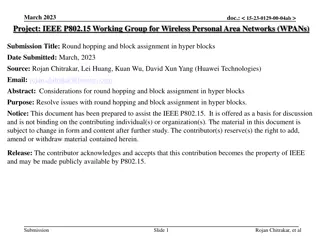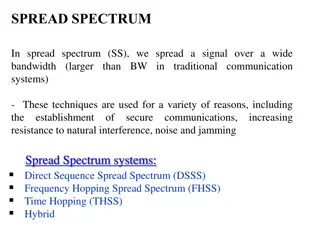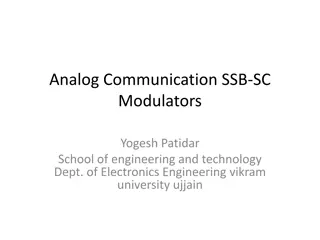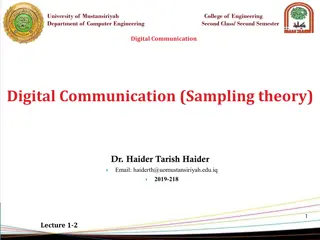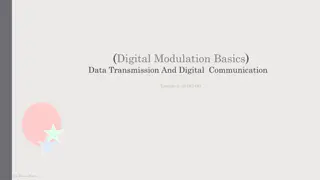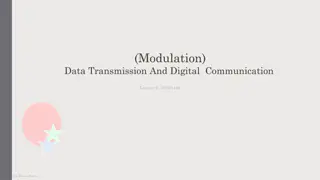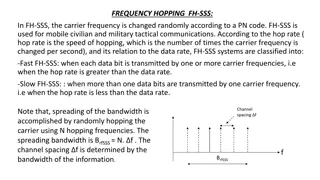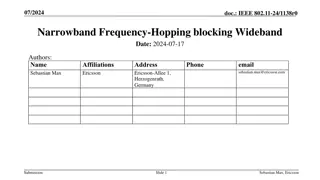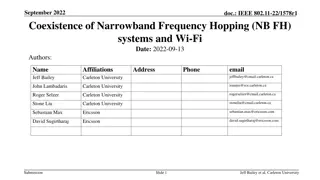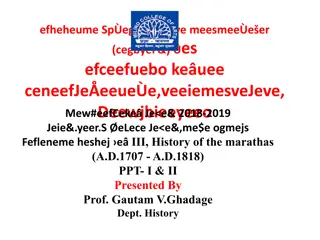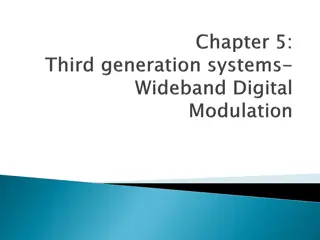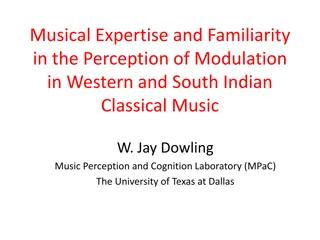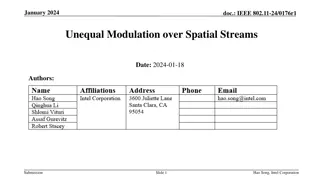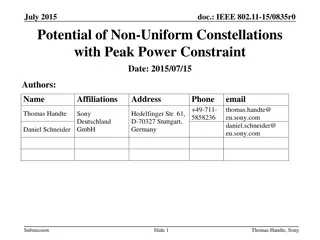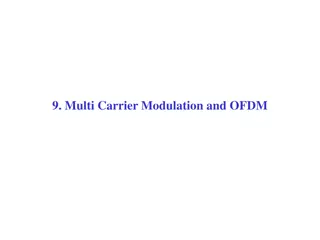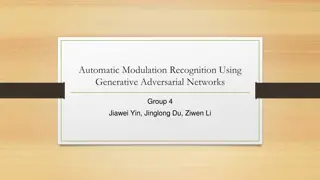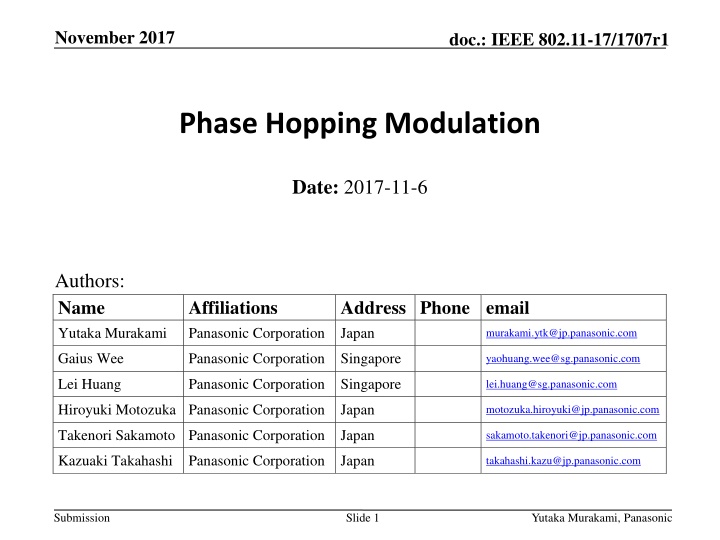
IEEE 802.11-17/1707r1 Phase Hopping Modulation Proposal
"Explore the proposal by Panasonic regarding Phase Hopping Modulation for OFDM in IEEE 802.11-17/1707r1. The submission discusses parameters, modulation sets, average throughput considerations, and the relationship between phase hopping and interleaving modulated symbols."
Download Presentation

Please find below an Image/Link to download the presentation.
The content on the website is provided AS IS for your information and personal use only. It may not be sold, licensed, or shared on other websites without obtaining consent from the author. If you encounter any issues during the download, it is possible that the publisher has removed the file from their server.
You are allowed to download the files provided on this website for personal or commercial use, subject to the condition that they are used lawfully. All files are the property of their respective owners.
The content on the website is provided AS IS for your information and personal use only. It may not be sold, licensed, or shared on other websites without obtaining consent from the author.
E N D
Presentation Transcript
November 2017 doc.: IEEE 802.11-17/1707r1 Phase Hopping Modulation Date: 2017-11-6 Authors: Name Yutaka Murakami Affiliations Panasonic Corporation Japan Address Phone email murakami.ytk@jp.panasonic.com yaohuang.wee@sg.panasonic.com Gaius Wee Panasonic Corporation Singapore Lei Huang Panasonic Corporation Singapore lei.huang@sg.panasonic.com Hiroyuki Motozuka Panasonic Corporation Japan motozuka.hiroyuki@jp.panasonic.com Takenori Sakamoto Panasonic Corporation Japan sakamoto.takenori@jp.panasonic.com Kazuaki Takahashi Panasonic Corporation Japan takahashi.kazu@jp.panasonic.com Submission Slide 1 Yutaka Murakami, Panasonic
November 2017 doc.: IEEE 802.11-17/1707r1 Introduction Draft IEEE802.11ay D0.8 [1] includes OLSM-PH (Open Loop Spatial Multiplexing with Phase Hopping)[2][3] as OLSM in OFDM. This contribution proposes parameters of OLSM-PH for OFDM and a change of the draft text. Submission Slide 2 Yutaka Murakami, Panasonic
November 2017 doc.: IEEE 802.11-17/1707r1 MCS in OLSM-PH for OFDM First of all, we discuss average throughput. Regarding average throughput, we consider the following points: - Basically, the same modulation orders are adopted. - X [bit/slot] keeps enough granularity where X is average throughput. - Modulation sets are selected without large difference of modulation orders. Therefore, we propose average throughput as 2, 4, 6, 8 and 12 [bit/slot] in OLSM-PH for OFDM. In OLSM-PH for OFDM, (SQPSK,SQPSK), (QPSK,QPSK), (QPSK,16QAM) , (16QAM,QPSK), (16QAM,16QAM) and (64QAM,64QAM) as modulation sets is supported. *1 slot is composed of 2 symbols (=1 [symbol/streams] x 2 [streams]). Submission Slide 3 Yutaka Murakami, Panasonic
November 2017 doc.: IEEE 802.11-17/1707r1 The motion passed regarding OLSM-PH for OFDM The contribution of [3] proposed OLSM-PH with precoding as OLSM and the following motion has been passed. Do you agree to modify the following in clause 6.1 of the SFD: For EDMG OFDM mode, the 11ay specification shall define SU EDMG PPDU transmission with and without phase hopping. An EDMG STA may support transmission and reception of SU EDMG PPDU with phase hopping. In this mechanism, the following apply: - Precoding may be used - The period of phase hopping is TBD. This contribution discusses and proposes parameters (i.e. precoding matrices, period of PH and so on) in OLSM-PH for OFDM. Submission Slide 4 Yutaka Murakami, Panasonic
November 2017 doc.: IEEE 802.11-17/1707r1 Relationship between PH and interleaving modulated symbols of first stream Symbol Interleaver Open loop precoder Phase hopping block Symbol Interleaver modulated symbols of second stream We propose that PH block is disposed before symbol interleaver operated in 16QAM and 64QAM. In this case, PER performance is improved in LOS environments, because an effect of phase hopping is obtained (i.e. each CW has equivalent number of each phase rotation). Submission Slide 5 Yutaka Murakami, Panasonic
November 2017 doc.: IEEE 802.11-17/1707r1 Proposed PH period (1/4) Regarding CW length (672= 25x3x7) of non-punctured codes, the contribution of [2] obtained the following result regarding PH period in vertical encoding. - PER performances with PH periods of 7, 8, 16, 32 and 64 are close. By the way, Draft P802.11ay D0.8 [1] defines DMG 7/8 codes with CW length 624(=24x3x13) and 1248(=25x3x13) for 7/8 transmission. Regarding these points, PH period is set to 8. The following slides discuss initializing scheme with PH period 8. Submission Slide 6 Yutaka Murakami, Panasonic
November 2017 doc.: IEEE 802.11-17/1707r1 Proposed PH period (2/4) The relationship between PH period (=8) and CW length in vertical encoding is shown when CW lengths are 672 and 624 (i.e. short code). Table 1: The number of required symbols when 1CW with 624 and 674 bits is transmitted. PH period 8 CW length 672 CW length 624 336 symbols =42 periods 312 symbols =39 periods (SQPSK,SQPSK) 168 symbols =21 periods 156 symbols =19.5 periods (QPSK,QPSK) 112 symbols =14 periods 104 symbols =13 periods (QPSK,16QAM) 84 symbols =10.5 periods 78 symbols =9.75 periods (16QAM,16QAM) 56 symbols =7 periods 52 symbols =6.5 periods (64QAM,64QAM) The number of yellow cell is 3. Submission Slide 7 Yutaka Murakami, Panasonic
November 2017 doc.: IEEE 802.11-17/1707r1 Proposed PH period (3/4) The relationship between PH period (=8) and CW length in vertical encoding is shown when CW lengths are 1344 and 1248 (i.e. long code). Table 2: The number of required symbols when 1CW with 1248 and 1344 bits is transmitted. PH period 8 CW length 1344 CW length 1248 672 symbols =84 periods 624 symbols =78 periods (SQPSK,SQPSK) 336 symbols =42 periods 312 symbols =39 periods (QPSK,QPSK) 224 symbols =28 periods 208 symbols =26 periods (QPSK,16QAM) 168 symbols =21 periods 156 symbols =19.5 periods (16QAM,16QAM) 112 symbols =14 periods 104 symbols =13 periods (64QAM,64QAM) There are one cell in PH period 8. Submission Slide 8 Yutaka Murakami, Panasonic
November 2017 doc.: IEEE 802.11-17/1707r1 Proposed PH period (4/4) Regarding treatment in yellow cell, we propose that PH is reset in the beginning of each codeword in all modulation cases supported in 30.6.6.3.9. Example : (QPSK,QPSK) with CW length 624 19.5 periods CW#2 CW#1 Stream#1 CW#1 CW#2 Stream#2 Phase[3] Phase[0] Reset Phase[0] *PH value is expressed as Phase[i] where i=0,1, ,7. Submission Slide 9 Yutaka Murakami, Panasonic
November 2017 doc.: IEEE 802.11-17/1707r1 Proposed precoding matrices (1/3) The contribution of [4] proposed additional SU-MIMO EDMG-Header-A fields to indicate whether precoding is applied or not, and the related motion has been passed. The principle to define precoding matrices is as follows. (SQPSK,SQPSK) : Same matrix as DCM (QPSK,QPSK) : Hadamard matrix (QPSK, 16-QAM) : A matrix to obtain maximal capacity (16-QAM,16-QAM), (64-QAM,64-QAM) : Hadamard matrix Submission Slide 10 Yutaka Murakami, Panasonic
November 2017 doc.: IEEE 802.11-17/1707r1 Proposed precoding matrices (2/3) data rate (bit/slot) PH without Precoding (stream#1, stream#2) PH with Precoding Principle 1 1 1 ? 1 0 0 1 2 (SQPSK, SQPSK) Same matrix as DCM ? 2 1 1 1 1 1 0 0 1 4 (QPSK, QPSK) Hadamard matrix 1 2 QPSK 2 3 0 A matrix to obtain maximal capacity 1 1 0 0 1 1 1 1 1 6 (QPSK, 16QAM) 2 4 3 0 16QAM 16QAM 4 3 0 A matrix to obtain maximal capacity 1 1 0 0 1 1 1 1 1 6 (16QAM, QPSK) 2 2 3 0 QPSK Submission Slide 11 Yutaka Murakami, Panasonic
November 2017 doc.: IEEE 802.11-17/1707r1 Proposed precoding matrices (3/3) data rate (bit/slot) PH without Precoding (stream#1, stream#2) PH with Precoding Principle 1 1 0 0 1 1 1 1 1 8 (16QAM, 16QAM) Hadamard matrix 2 1 1 0 0 1 1 1 1 1 12 (64QAM, 64QAM) Hadamard matrix 2 Submission Slide 12 Yutaka Murakami, Panasonic
November 2017 doc.: IEEE 802.11-17/1707r1 Discussion of performance The contributions of [2][3] showed that OLSM + PH scheme has an advantage for performance in LOS environment. In addition, the following results were obtained. - Performance with non-precoding + PH in (SQPSK,SQPSK), (QPSK,QPSK), (16QAM,16QAM) and (64QAM,64QAM) - Performance with Hadamard precoding + PH in (QPSK,QPSK), (16QAM,16QAM) and (64QAM,64QAM) - PER performances with PH periods of 7 and 8 are close Therefore, PER performances at the following cases in LOS environment are discussed. - (SQPSK,SQPSK) with precoding(/non-precoding) + PH - (QPSK,16QAM) with precoding/non-precoding + PH Submission Slide 13 Yutaka Murakami, Panasonic
November 2017 doc.: IEEE 802.11-17/1707r1 Simulation conditions MIMO* :Comparison of precoding/no precoding with/without PH Period of PH is 8. Phase change matrix : 1 0 ??3? ? ??? 8 0 4 * Vertical encoding is adapted Modulation sets : (SQPSK,SQPSK),(QPSK,16QAM) Channel model : LOS model #1 (See Appendix) =-5dB ( is power attenuation coefficient of cross-link terms) FEC : 11ad LDPC codes (Codeword size=672 bits) Detection : MLD(Maximum Likelihood Detection), MMSE (Minimum Mean Square Error) Submission Slide 14 Yutaka Murakami, Panasonic
November 2017 doc.: IEEE 802.11-17/1707r1 (1)Comparison: no-precoding with/without PH (LOS #1: =-5dB; MLD) (QPSK,16QAM) (SQPSK,SQPSK) PH has gain Submission Slide 15 Yutaka Murakami, Panasonic
November 2017 doc.: IEEE 802.11-17/1707r1 (2)Comparison: precoding with/without PH (LOS #1: =-5dB; MLD) (SQPSK,SQPSK) (QPSK,16QAM) In both non-precoding and precoding cases, PH has gain when using MLD. Submission Slide 16 Yutaka Murakami, Panasonic
November 2017 doc.: IEEE 802.11-17/1707r1 (3)Comparison: no-precoding with/without PH (LOS #1: =-5dB; MMSE) (SQPSK,SQPSK) (QPSK,16QAM) Submission Slide 17 Yutaka Murakami, Panasonic
November 2017 doc.: IEEE 802.11-17/1707r1 (4)Comparison: precoding with/without PH (LOS #1: =-5dB; MMSE) (SQPSK,SQPSK) (QPSK,16QAM) In MMSE case, there are several cases that PH has gain. Submission Slide 18 Yutaka Murakami, Panasonic
November 2017 doc.: IEEE 802.11-17/1707r1 Simulation conditions MIMO* : Comparison of precoding/no precoding with PH Period of PH is 8. Phase change matrix : 1 0 ??3? ? ??? 8 0 4 * Vertical encoding is adapted. Modulation sets : (SQPSK,SQPSK), (QPSK,16QAM) Channel model : LOS model #2 (See Appendix) =0dB( is power attenuation coefficient of cross-link terms.) =-5dB, -10dB ( is coefficient of gain difference in transmitter and receiver.) FEC : 11ad LDPC codes (Codeword size=672 bits) Detection : MLD, MMSE Submission Slide 19 Yutaka Murakami, Panasonic
November 2017 doc.: IEEE 802.11-17/1707r1 (1)Performances with power imbalance (LOS #2: =-5dB; MLD) (QPSK,16QAM) (SQPSK,SQPSK) Precoding + PH has large gain Submission Slide 20 Yutaka Murakami, Panasonic
November 2017 doc.: IEEE 802.11-17/1707r1 (2)Performances with power imbalance (LOS #2: =-5dB; MMSE) (SQPSK,SQPSK) (QPSK,16QAM) In UEP case, performance with precoding + PH is better. Submission Slide 21 Yutaka Murakami, Panasonic
November 2017 doc.: IEEE 802.11-17/1707r1 (3)Performances with power imbalance (LOS #2: =-10dB; MLD) (SQPSK,SQPSK) (QPSK,16QAM) Precoding + PH has large gain Submission Slide 22 Yutaka Murakami, Panasonic
November 2017 doc.: IEEE 802.11-17/1707r1 (4)Performances with power imbalance (LOS #2: =-10dB; MMSE) (SQPSK,SQPSK) (QPSK,16QAM) In UEP case, introducing precoding + PH is useful. Submission Slide 23 Yutaka Murakami, Panasonic
November 2017 doc.: IEEE 802.11-17/1707r1 Summary Following parameters in OLSM-PH for OFDM are proposed. - Average throughput of 2, 4, 6, 8 and 12 [bit/slot] is supported. - PH block is disposed before symbol interleaver operated in 16QAM and 64QAM. - PH period is set to 8. - A PH reset scheme is proposed. - Precoding matrix for OLSM-PH is proposed (See slides 11 and 12). Submission Slide 24 Yutaka Murakami, Panasonic
November 2017 doc.: IEEE 802.11-17/1707r1 References 1) Draft P802.11ay_D0.8 2) 11-16-0669-01-00ay-open-loop-spatial-multiplexing-with-phase-hopping-for-11ay 3) 11-16-0959-00-00ay-open-loop-spatial-multiplexing-with-phase-hopping-for-11ay 4) 11-16-1444-00-00ay-edmg-phy-headers-for-open-loop-spatial-multiplexing-in-su- mimo 5) 11-16-0388-00-00ay-performance-analysis-of-open-loop-su-mimo-receivers-for- ieee-802-11ay Submission Slide 25 Yutaka Murakami, Panasonic
November 2017 doc.: IEEE 802.11-17/1707r1 Appendix Submission Slide 26 Yutaka Murakami, Panasonic
November 2017 doc.: IEEE 802.11-17/1707r1 LOS Model #1 [5] LOS model #1 is a line of sight which has a cross-link power attenuation. Channel matrix ?#1 of 2x2 MIMO systems in LOS model #1 is expressed as: ???11 ????12 ????21 ???22 where ??? is phase of channel component between transmit antenna v and receive antenna u, and is a power attenuation coefficient of cross-link terms. The LOS model #1 supposes that phases of channel components are independent random variables and uniformly distributed from 0 to 2 and phases of channel components are quasi-static parameters (i.e. Block fading (constant for each PPDU (PPDU length=8192 bytes))). The cross-link power attenuation coefficient depends on the coupling between transmit antennas and the distance between transmit and receive antennas. The coefficient has a range from 0 to 1. ?#1= Submission Slide 27 Yutaka Murakami, Panasonic
November 2017 doc.: IEEE 802.11-17/1707r1 LOS Model #2 [3] In LOS model #1, we add following scenarios (UEP: unequal power): Scenario 1: Considering individual difference of transmitter and so on, difference of antenna gain between 2 transmit antennas exists. Scenario 2: Considering individual difference of receiver and so on, difference of antenna gain between 2 receive antennas exists. Considering Scenarios 1 and 2, channel matrix ?#2 of 2x2 MIMO systems in LOS model #2 is expressed as: ???11 ????12 ????21 ????22 where is a coefficient of gain difference. The UEP coefficient has a range from 0 to 1. Note that : For simplification of UEP performance evaluation, is set to 0. ?#2= Submission Slide 28 Yutaka Murakami, Panasonic




